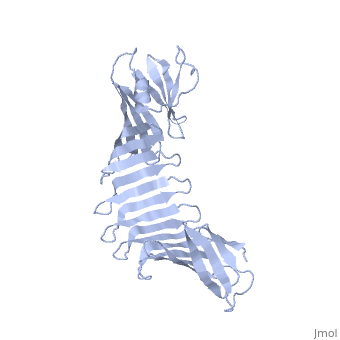From Proteopedia
proteopedia linkproteopedia link |
Outer surface proteins (Osp) are produced by the bacteria Borrelia burgdorferi which causes Lyme disease. OspA and OspB are upregulated when the bacteria enter the tick.
- OspA[1] contributes to the colonization of the gut by the bacteria.
- OspB[2], OspC[3] and OspE[4] are major antigens on the surface of the Lyme disease spirochetes when it is being transmitted to humans. For more details see:
OspA -
OspB -
OspC -
OxpA, OspB and OspC -
|
3D structures of Outer surface proteins (Updated on 17-July-2024)
References
- ↑ Pal U, de Silva AM, Montgomery RR, Fish D, Anguita J, Anderson JF, Lobet Y, Fikrig E. Attachment of Borrelia burgdorferi within Ixodes scapularis mediated by outer surface protein A. J Clin Invest. 2000 Aug;106(4):561-9. PMID:10953031 doi:http://dx.doi.org/10.1172/JCI9427
- ↑ Neelakanta G, Li X, Pal U, Liu X, Beck DS, DePonte K, Fish D, Kantor FS, Fikrig E. Outer surface protein B is critical for Borrelia burgdorferi adherence and survival within Ixodes ticks. PLoS Pathog. 2007 Mar;3(3):e33. PMID:17352535 doi:10.1371/journal.ppat.0030033
- ↑ Carrasco SE, Troxell B, Yang Y, Brandt SL, Li H, Sandusky GE, Condon KW, Serezani CH, Yang XF. Outer surface protein OspC is an antiphagocytic factor that protects Borrelia burgdorferi from phagocytosis by macrophages. Infect Immun. 2015 Dec;83(12):4848-60. doi: 10.1128/IAI.01215-15. Epub 2015 Oct, 5. PMID:26438793 doi:http://dx.doi.org/10.1128/IAI.01215-15
- ↑ Lam TT, Nguyen TP, Montgomery RR, Kantor FS, Fikrig E, Flavell RA. Outer surface proteins E and F of Borrelia burgdorferi, the agent of Lyme disease. Infect Immun. 1994 Jan;62(1):290-8. PMID:8262642

